Your smartphone’s operating system determines your smartwatch choice: iPhone users must select Apple Watch with watchOS, while Android users can choose Wear OS devices from various brands like Samsung, Fossil, or Motorola. Consider your priorities—Apple Watch excels in health features like ECG monitoring and seamless iOS integration, while Wear OS offers budget-friendly options, longer battery life, and extensive customization. Each platform provides distinct advantages that’ll help guide your final decision.
Platform Compatibility and Device Pairing Requirements
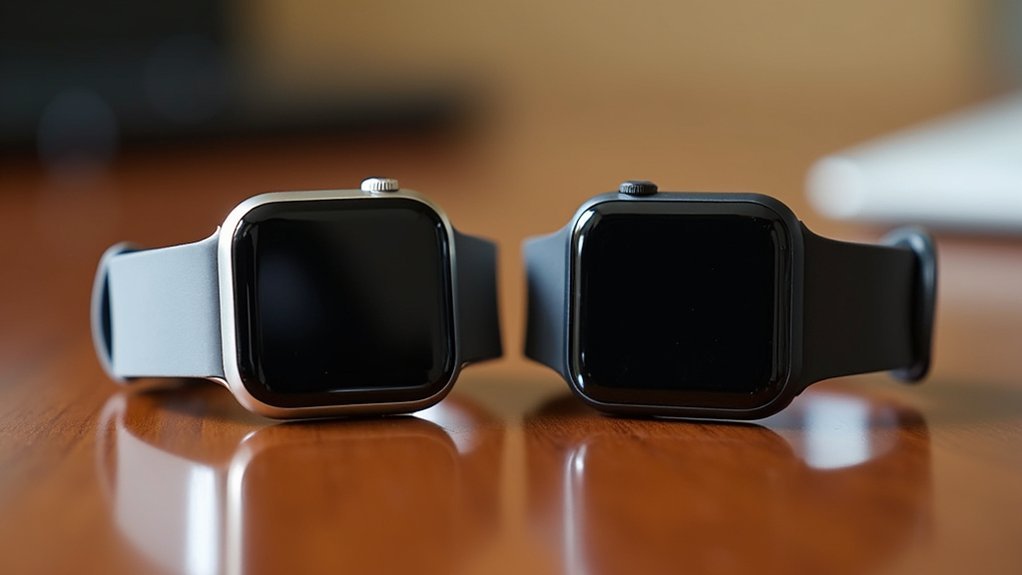
When choosing between Wear OS and watchOS, your smartphone’s operating system will largely determine which smartwatch platform you can use effectively.
Your smartphone’s operating system is the deciding factor when selecting between these two major smartwatch platforms.
If you’re an iPhone user, watchOS is your only option since Apple Watch exclusively pairs with iOS devices. However, if you own an Android phone, you’ll get the best experience with Wear OS through seamless Google services integration and full functionality access.
Wear OS does offer some cross-platform flexibility by working with both Android and iOS devices, though iPhone users will face significant limitations compared to the streamlined experience Apple provides.
Popular Wear OS devices like the TicWatch Pro 5 offer compelling alternatives with features such as extended battery life and military-grade durability standards.
For peak performance, verify your device meets minimum requirements: Wear OS needs a recent Android version, while watchOS requires a compatible iOS version for proper functionality.
Hardware Options and Brand Availability
Beyond compatibility considerations, the hardware landscape reveals stark differences between these two platforms.
Wear OS offers you extensive brand diversity with options from Samsung, Motorola, Fossil, Skagen, and Mobvoi. You’ll find everything from budget-friendly devices to premium models, with customizable watch faces, various case materials like stainless steel and titanium, and multiple color choices. This variety means you can select designs ranging from sporty to elegant. Recent updates to WearOS promise smoother multitasking and better battery optimization across these diverse hardware options.
WatchOS limits you to Apple Watch exclusively, though it compensates with premium build quality and Apple’s proprietary S-series chips known for superior performance.
While you’ll miss brand diversity, you’ll get seamless integration with other Apple devices and consistently sleek, minimalist design. Your choice depends on whether you prioritize hardware variety or premium exclusivity.
App Store Quality and Application Selection

When you’re selecting a smartwatch platform, you’ll encounter stark differences in app quality standards between Apple’s curated App Store and Google’s more open Play Store approach.
Apple’s strict review process guarantees consistent, polished applications but limits variety, while Google’s flexible policies offer broader selection with variable quality control. Wear OS enables comprehensive daily task management including meetings, directions, grocery lists, and payments directly from your wrist.
Your choice between these platforms will largely depend on whether you prioritize assured app refinement or prefer access to a wider range of applications with varying levels of optimization.
App Quality Standards
Although both smartwatch platforms offer functional app stores, the quality and selection standards reveal significant differences that’ll impact your daily experience.
Apple’s watchOS maintains stricter quality control measures, guaranteeing more consistent app performance across all devices. This translates to fewer crashes, better optimization, and smoother user interactions.
Wear OS faces challenges with fragmentation due to varying hardware configurations, which can affect app reliability. However, Google’s actively working to improve developer incentives and ecosystem support. Major apps like Spotify and Strava are now optimized specifically for WearOS, representing significant improvements in the platform’s app ecosystem.
Key quality differences include:
- App Optimization: watchOS 10’s redesigned layout makes info-dense applications feel less cramped on rectangular displays
- Performance Consistency: Apple’s unified hardware approach guarantees apps run similarly across all Apple Watch models
- Developer Standards: Stricter App Store guidelines result in higher-quality applications reaching users
Developer Platform Preferences
The app quality standards we’ve examined stem largely from how each platform attracts and supports its developer community.
Apple’s developer-first approach gives you access to Xcode templates and Swift coding tools that streamline watchOS development. This translates into thousands of optimized apps from top iOS developers who consistently release watchOS counterparts. You’ll find Apple’s ecosystem encourages seamless app integration and standalone functionality without phone dependency.
Google supports Wear OS developers through Android Studio with Java and Kotlin tools, but historically you’ve had fewer app choices. However, Google’s increasing developer incentives are expanding the app library with key additions like Spotify and Strava. Google is also encouraging more app developers to create Wear OS Tiles for better app availability and improved user experience.
While both platforms now support companion and standalone apps, watchOS maintains its lead in developer adoption and app diversity.
Health and Fitness Tracking Capabilities
You’ll find both Wear OS and watchOS excel at tracking fundamental health metrics like heart rate, steps, and sleep patterns, though their approaches differ markedly.
The real distinction emerges when you examine advanced medical features such as ECG monitoring and blood oxygen measurement, where Apple Watch currently holds a technical edge.
Your choice will also depend on how well each platform integrates with your preferred fitness apps and whether you value Apple’s tightly controlled ecosystem or Wear OS’s more open approach to third-party health services. However, Wear OS 4 provides more extensive fitness tracking capabilities with features like stress tracking, heart zone training, and Auto Workout detection that offer deeper insights into your overall wellness.
Core Health Metrics
Fitness enthusiasts and health-conscious users will find both Wear OS and watchOS deliver extensive tracking capabilities, though their approaches differ markedly.
You’ll get heart rate monitoring across all devices on both platforms, with continuous tracking options available. Sleep tracking comes standard, though Apple’s watchOS 10 provides more detailed sleep stage analysis and long-term trends.
Both platforms handle step counting and activity tracking well, but their specialized features vary:
- Advanced metrics: Apple Watch offers VO2 Max and environmental noise monitoring, while Samsung’s Wear OS devices provide body composition analysis.
- Workout variety: watchOS supports extensive indoor/outdoor activities including swimming, while Wear OS focuses on auto-detection.
- Goal systems: Apple’s activity rings versus Wear OS’s customizable daily targets.
Apple Watch health data gets stored in the iPhone’s Health app, which links to your Apple account for easy transfer between devices. Your choice depends on which specialized health metrics matter most to your fitness routine.
Advanced Medical Features
While both platforms excel at basic health monitoring, their advanced medical features reveal substantial differences in sophistication and reliability.
WatchOS delivers extensive ECG monitoring with built-in atrial fibrillation detection, seamless blood oxygen tracking, and automatic fall detection that triggers emergency alerts. You’ll find these features work consistently across Apple Watch models with minimal setup required.
Wear OS offers similar capabilities, but implementation varies considerably by manufacturer. ECG support exists mainly on premium devices like Samsung Galaxy Watch, while SpO2 monitoring often requires third-party apps or manual activation.
Fall detection isn’t standardized across Wear OS devices, making it less reliable for emergency situations. Google Fit enables effective health monitoring and workout tracking across Wear OS devices.
Apple Watch provides superior integration with medical services, research studies, and healthcare providers, making it the stronger choice for serious health monitoring needs.
Fitness App Integration
Beyond core health monitoring, both platforms transform into extensive fitness hubs through their app ecosystems, though each takes a distinctly different approach.
Wear OS embraces an open ecosystem that welcomes diverse third-party fitness apps like Strava and Spotify, giving you broader compatibility choices.
Meanwhile, watchOS creates a tightly integrated experience centered around Apple Health, offering seamless data synchronization across your Apple devices. Apple Health serves as a central repository for various health data from multiple sources, making it easier to consolidate information from different fitness tracking devices and apps.
Your platform choice greatly impacts which fitness apps you’ll access:
- Wear OS supports Google Fit integration plus popular apps like Strava, benefiting from Google’s services ecosystem
- watchOS provides optimized apps like Nike Training Club that leverage Apple Watch’s specific hardware capabilities
- Cross-platform compatibility varies, with Wear OS offering broader Android/iOS support versus watchOS’s iOS-exclusive design
Performance and Processing Power Comparison
Two distinct approaches define how Wear OS and WatchOS handle performance and processing power. You’ll find that Apple’s proprietary S-series chips deliver consistently fast, lag-free operation across all Apple Watch models. Meanwhile, Wear OS relies on various chipsets from different manufacturers, creating performance variations depending on your specific device.
| Feature | WatchOS | Wear OS |
|---|---|---|
| Chipset | S-series (optimized) | Various manufacturers |
| Performance | Consistently fast | Hardware-dependent |
| Multitasking | Seamless integration | Improved but limited |
WatchOS excels in seamless multitasking and optimized RAM management, while Wear OS has improved notably with recent updates. You’ll experience more reliable performance with Apple’s unified hardware-software approach, though high-end Wear OS devices can deliver competitive processing power for most smartwatch tasks. Leading manufacturers like Google and Samsung continue to push Wear OS performance forward with their flagship smartwatch offerings.
User Interface Design and Navigation Experience
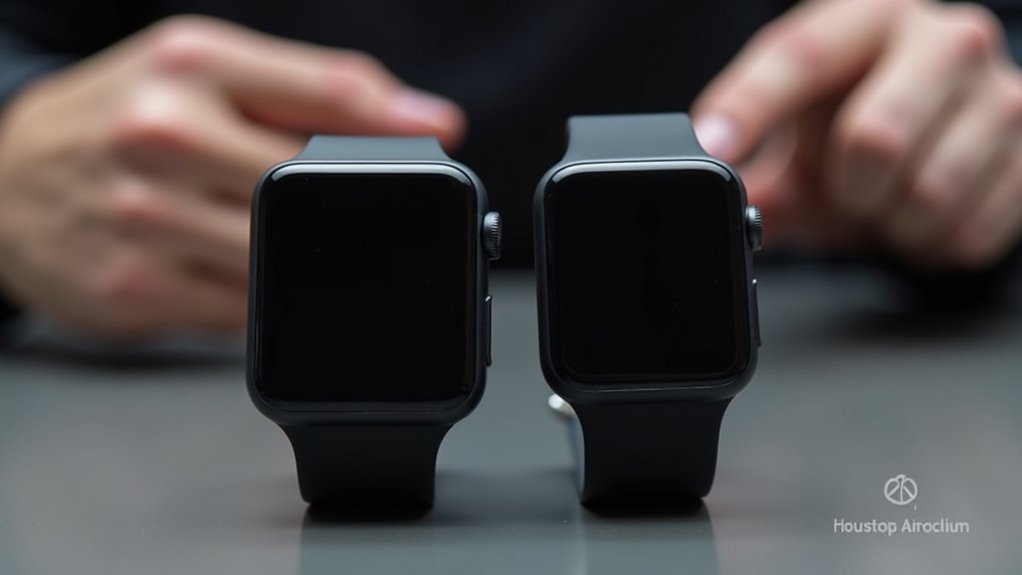
When you’re deciding between Wear OS and watchOS, you’ll notice each platform takes a distinctly different approach to how you navigate and interact with your smartwatch.
Wear OS relies heavily on horizontal swiping between tiles and vertical gestures for notifications, while watchOS emphasizes its Digital Crown for scrolling and a mix of taps, swipes, and force touch interactions.
The visual design philosophies also differ markedly—Wear OS prioritizes simplicity with one piece of information per screen, whereas watchOS packs more data into complications and widgets for denser information display. Apple’s latest watchOS 10 can display two cards per screen in its widget system, making better use of the available screen real estate.
Screen Navigation Methods
Although both Wear OS and watchOS have evolved considerably in their navigation approaches, they offer distinctly different experiences that’ll shape how you interact with your smartwatch daily.
Wear OS provides swipeable tiles and menus, creating an intuitive flow for accessing information quickly. You’ll find enhanced physical navigation options like rotating crowns or bezels on many devices, giving you multiple ways to interact with your watch. Recent platform updates have introduced new libraries that enable developers to create more sophisticated navigation experiences.
watchOS focuses on glanceable information with its Digital Crown and Force Touch combination, delivering seamless navigation through shortcuts and streamlined interfaces.
Key navigation differences include:
- Physical controls: Wear OS offers rotating bezels/crowns while watchOS uses Digital Crown with Force Touch
- Screen interaction: Wear OS emphasizes swipeable tiles; watchOS prioritizes quick-access shortcuts
- Information display: Wear OS supports larger screens; watchOS maintains minimalist, consistent layouts
Visual Design Philosophy
Beyond navigation mechanics, the fundamental design philosophies of Wear OS and watchOS create entirely different visual experiences that’ll influence every interaction with your smartwatch.
Wear OS embraces simplicity through its circular framework, though this constrains button placement and creates text layout challenges. You’ll find the round displays struggle with information density compared to rectangular alternatives.
WatchOS leverages its rectangular design for efficient space utilization, allowing straightforward button placement and info-dense applications without cramping. You can display more content clearly and access customizable widgets directly on your watch face.
While Wear OS 6 introduces dynamic theming and Material 3 Expressive features for visual cohesion, watchOS maintains consistent design standards across all apps, making your interaction more predictable and organized. The latest Wear OS update includes fluid scrolling animations that enhance the overall navigation experience with smoother transitions between screens.
Battery Life and Power Management
Battery life represents one of the most practical differences between Wear OS and WatchOS, directly affecting how you’ll use your smartwatch daily.
Battery performance often determines whether your smartwatch becomes an essential daily companion or another device requiring constant attention.
Apple Watch typically delivers 18-24 hours per charge, requiring nightly charging under normal use. Wear OS devices offer more variety, with standard models lasting 24-48 hours and high-end options like OnePlus Watch achieving 3-5 days of regular use. Specialized models like the OnePlus Watch 2 utilize a low-powered coprocessor that handles background tasks to maximize battery efficiency.
- Power saving flexibility: Wear OS provides ultra-low-power modes extending battery to 12-16 days, while Apple Watch offers only brief extension options.
- Heavy usage performance: GPS workouts and continuous health tracking drain both platforms, but Wear OS hybrids manage multi-day use better.
- Charging convenience: Apple Watch supports fast charging (80% in 30 minutes), while most Wear OS devices require longer charge times.
Google Services Integration Vs Apple Ecosystem
When selecting between Wear OS and watchOS, your choice of smartphone ecosystem fundamentally determines which smartwatch will serve you best.
If you’re deeply integrated with Google services, Wear OS provides seamless access to Gmail, Google Maps, Google Pay, and YouTube Music directly from your wrist. You’ll enjoy “Hey Google” voice commands and robust third-party app support through the Play Store. The latest Wear OS 6 introduces Material 3 Expressive design system specifically optimized for round displays, enhancing the visual experience across apps and tiles.
Apple Watch users benefit from cohesive integration with iMessage, Apple Maps, Apple Pay, and Apple Music. The platform’s standout features include Handoff functionality, allowing you to start tasks on your iPhone and continue on your watch, plus thorough health data syncing across all Apple devices.
Cross-platform compatibility remains limited—Google services barely function on watchOS, while Apple services aren’t available on Wear OS.
Connectivity Features and Smart Assistant Support
How well your smartwatch connects to networks and responds to voice commands can make or break your daily experience.
Your smartwatch’s network connectivity and voice command responsiveness directly impacts how smoothly it integrates into your daily routine.
Wear OS offers broader connectivity options including Bluetooth, NFC, Wi-Fi, 3G, and LTE, letting you operate more independently from your phone. You’ll get Google Assistant (evolving into Gemini) with deep integration to Google services and complex query handling.
watchOS focuses on Bluetooth, Wi-Fi, and LTE in cellular models, but requires tighter iPhone integration. Siri excels within Apple’s ecosystem, seamlessly controlling your other Apple devices and accessing them with your wrist. Apple’s voice assistant also supports 45 languages for international users.
Key connectivity differences include:
- Network flexibility: Wear OS supports more protocols for standalone operation
- Voice assistant scope: Google Assistant handles broader queries; Siri dominates Apple ecosystem tasks
- Cross-device features: watchOS enables seamless Apple device access and handoff capabilities
Pricing Tiers and Value Propositions
Your smartwatch budget greatly impacts which features you’ll access and how well your device integrates with your daily routine. Wear OS offers three distinct pricing tiers, while WatchOS primarily targets premium users.
| Price Range | Wear OS Options | WatchOS Options |
|---|---|---|
| $100-$250 | Fossil, budget Samsung models | None available |
| $200-$300 | Galaxy Watch 6 Classic | Older Apple Watch models |
| $300-$400 | Galaxy Watch 7, Pixel Watch 3 | Current Apple Watch lineup |
| Advanced Features | Fall detection, Fitbit integration | Seamless iOS integration |
| Ecosystem Support | Wide Android compatibility | Exclusive to Apple users |
Wear OS provides more budget-friendly entry points and broader device compatibility. You’ll find robust health tracking across all tiers, though premium models offer enhanced safety features and software polish. Your smartphone ecosystem ultimately determines the best value proposition for your needs. When choosing budget options, consider spending at least the equivalent of $3,500 INR to ensure better quality software and health tracking capabilities.
Customization Options and Watch Face Variety
While both platforms offer compelling personalization features, Wear OS and WatchOS take fundamentally different approaches to watch face customization.
You’ll find Wear OS embraces Android’s open philosophy, offering extensive third-party watch face options and deeper UI customization through Material You theming. The platform automatically adapts colors across your entire interface based on your phone’s wallpaper and preferences.
WatchOS takes a more curated approach with Apple-designed faces featuring interactive complications optimized for quick data access. You’ll get consistent aesthetic quality but fewer radical modification options.
Key customization differences include:
- Color theming: Wear OS offers dynamic Material You adaptation vs. watchOS’s fixed color schemes
- Third-party support: Wear OS supports broader manufacturer variety while watchOS remains Apple-exclusive
- UI flexibility: Wear OS allows swappable tiles and widgets beyond standard complications
When selecting between these platforms, your family’s tech preferences and existing device ecosystem should guide your decision.
Long-term Software Support and Updates
Beyond customization features, the platform you choose will determine how long your smartwatch remains current with security patches and new capabilities.
Apple typically provides software support for several years, with watchOS updates reaching devices like the Series 6 and newer models. You’ll receive consistent updates that maintain seamless integration across your Apple ecosystem.
Apple’s extended software support ensures your Apple Watch stays current with regular watchOS updates for years after purchase.
Wear OS offers shorter support cycles, usually lasting two to three years. Google’s Pixel Watch receives about three years of updates, while other manufacturers like OnePlus promise only a couple of OS updates. Wear OS works with multiple manufacturers, giving you various hardware options compared to Apple’s single-brand approach.
This means you’ll likely need to replace your Wear OS device sooner.
If you prioritize longevity and consistent updates, watchOS offers better long-term value and keeps your device relevant longer.
Frequently Asked Questions
Can I Switch From Apple Watch to Wear OS Without Losing Data?
You can’t transfer Apple Watch data to Wear OS due to Apple’s closed ecosystem. You’ll lose health, fitness, and app data when switching. You’ll need to start fresh with Google Fit and Wear OS services.
Which Platform Is Better for Enterprise and Business Use Cases?
You’ll find Wear OS better for cross-platform flexibility and Google integration, while watchOS excels in Apple ecosystems with superior security. Choose Wear OS for customization and broader compatibility, watchOS for seamless Apple integration.
Are There Any Privacy Differences Between Wear OS and Watchos?
Yes, you’ll find significant privacy differences. WatchOS prioritizes data confidentiality with minimal third-party sharing, while Wear OS integrates deeply with Google’s ecosystem, collecting more data for personalized services and advertisements.
Can I Use My Smartwatch Offline Without Phone Connectivity?
You can use your smartwatch offline for basic functions like fitness tracking, music playback, and notifications. Cellular models offer more independence, while core health sensors work without any connectivity required.
Which Platform Receives Security Patches and Updates More Frequently?
You’ll receive security patches and updates more frequently with watchOS. Apple provides 6-7 years of support with regular patches, while Wear OS typically offers only 2-3 years with inconsistent update schedules.
In Summary
Your choice between Wear OS and watchOS ultimately depends on your smartphone ecosystem and priorities. If you’re an iPhone user, watchOS delivers seamless integration and superior health tracking. Android users should consider Wear OS for better compatibility, though you’ll sacrifice some polish. Evaluate your budget, desired features, and long-term needs. Both platforms offer solid experiences, but ecosystem compatibility remains the most essential factor in making your decision.


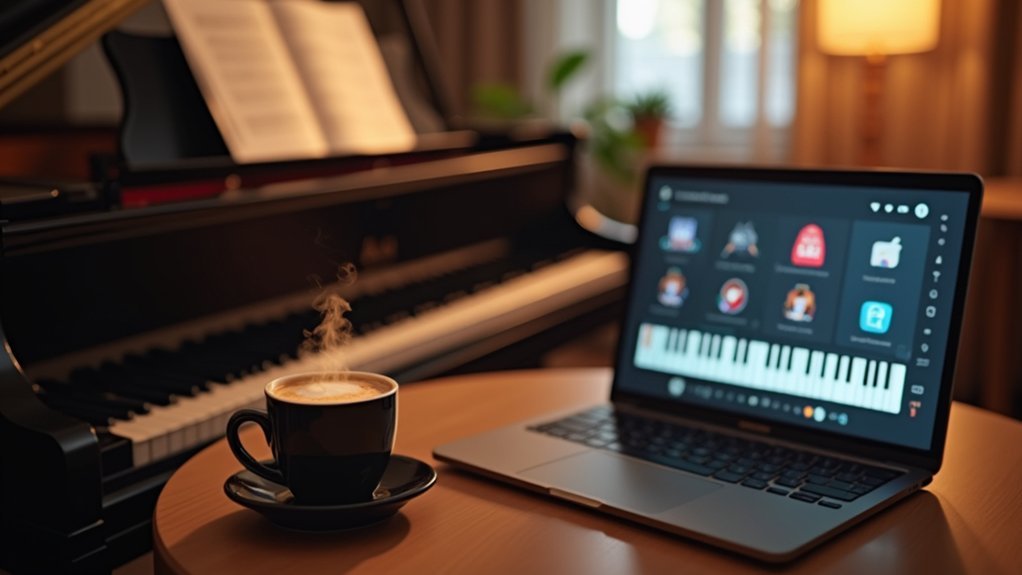
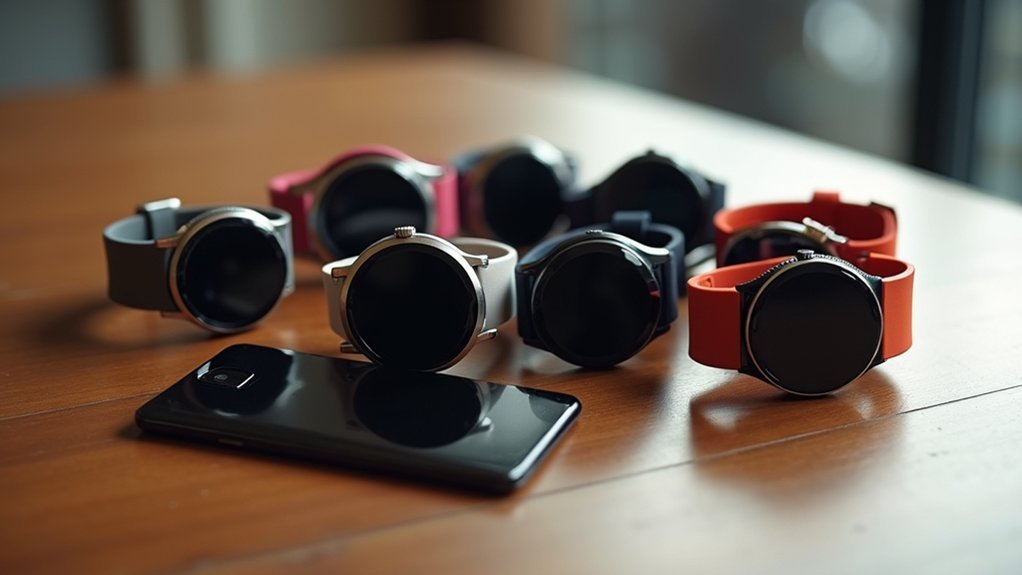
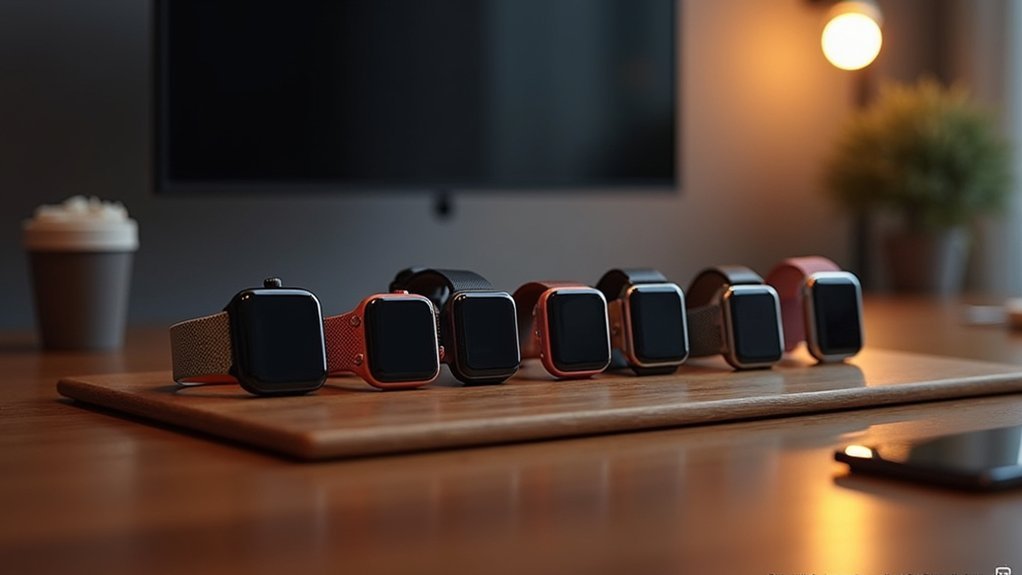
Leave a Reply